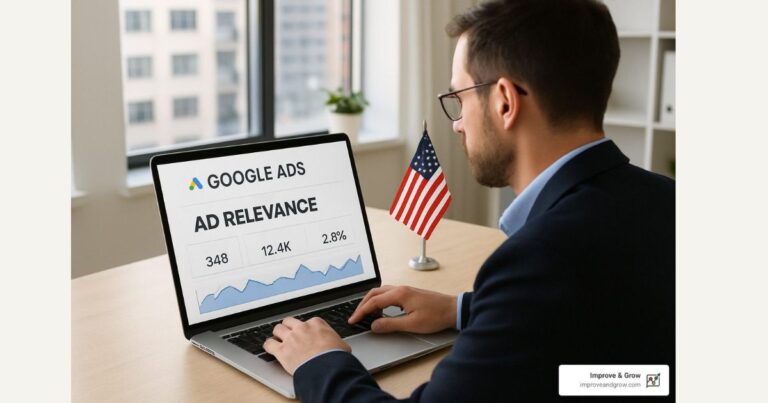Why Ad Relevance Makes or Breaks Your Google Ads ROI
How to improve ad relevance is critical for any business running Google Ads campaigns. If you’re looking to immediately boost your ad performance, here are the essential steps:
- Create tightly-themed ad groups with 5-10 closely related keywords
- Include target keywords in headlines and descriptions
- Match ad messaging to landing page content
- Optimize landing pages for speed and mobile experience
- Use negative keywords to filter irrelevant searches
- Test multiple ad variations to find winners
Did you know that 70% of ads have poor ad relevance? This means only $3 out of every $10 spent keeps visitors engaged and has a real chance to convert. For local service businesses, the statistics are equally concerning.
“Ad relevance isn’t just a metric—it’s the difference between wasting your budget and turning clicks into customers,” explains Alex Mallin, PPC Specialist at Improve & Grow. “When your ads closely match what potential customers are searching for, you win in three ways: lower costs, better ad positions, and higher conversion rates.”
Ad relevance is one of three core components of Google’s Quality Score (alongside Expected CTR and Landing Page Experience). When Google rates your keywords as having “Above Average” relevance instead of “Below Average,” you can expect to pay significantly less per click while appearing in better positions.
For contractors and service businesses, this means the difference between paying $15 per click or just $5 for the same potential customer. Those savings add up quickly, allowing you to reach more customers within the same budget.
But relevance isn’t just about saving money—it’s about creating a seamless experience from search to click to conversion. When someone searches for “emergency plumber near me” and sees an ad specifically mentioning emergency plumbing services in their city with a clear call to action, they’re far more likely to click and convert than if they see a generic plumbing services ad.
In the sections that follow, we’ll break down exactly how to improve your ad relevance step by step, with practical tactics you can implement today.

Why Ad Relevance Is Your Hidden Profit Lever
When contractors and local service businesses come to us, they’re often shocked to find they’ve been overpaying for clicks due to poor ad relevance. This overlooked aspect of Google Ads isn’t just another metric—it’s a powerful profit lever that directly impacts your bottom line.
“Most contractors don’t realize they’re leaving money on the table with poorly structured ads,” explains Alex Mallin, PPC Specialist at Improve & Grow. “Improving ad relevance is like finding a 30-50% off coupon for your advertising costs that also boosts results.”
Here’s why ad relevance matters so much to your business:
Lower Cost-Per-Click (CPC) is perhaps the most immediate benefit. Google rewards relevant ads with significant discounts—often up to 50% less than what your competitors are paying for the exact same bid amount. Imagine cutting your advertising costs in half while maintaining the same visibility.
Higher Ad Positions come naturally with better relevance. Even with lower bids, your highly relevant ads can outrank competitors who are paying more but have poor relevance scores. This means more visibility without the premium price tag.
Improved Conversion Rates follow when your ad matches what the searcher is looking for and leads to a consistent landing page experience. We typically see conversion rates increase by 25-50% when ad relevance is optimized—turning more of those expensive clicks into actual paying customers.
Reduced Wasted Spend is another major benefit. Think about it: irrelevant clicks rarely convert into customers, meaning that improving relevance directly reduces money thrown away on the wrong prospects.
The difference between high and low relevance campaigns is striking:
| Metric | High Relevance | Low Relevance |
|---|---|---|
| Average CPC | $3-5 | $8-15 |
| Typical Ad Position | 1-2 | 3-5 |
| Click-Through Rate | 5-10% | 1-3% |
| Conversion Rate | 8-15% | 2-5% |
| Cost Per Lead | $50-100 | $200-400 |
The Quality Score Formula in Plain English
Google’s Quality Score might seem like a mysterious black box, but it’s actually quite straightforward. Think of it as Google’s way of rating how good your ads are for users who see them. It consists of three main components:
Expected Click-Through Rate (CTR) measures how likely users are to click your ad when it appears. Google wants to show ads people will actually click on.
Ad Relevance evaluates how closely your ad copy matches what the user is searching for. Are you directly addressing their search query?
Landing Page Experience assesses how useful and user-friendly your landing page is after someone clicks. Does it deliver what the ad promised?
While your bid amount still matters, a high Quality Score can help you win better positions at lower costs. Here’s a simplified version of how Google determines where your ad appears:
Ad Rank = Bid Amount × Quality Score
This formula explains why a contractor with excellent ad relevance could pay just $5 per click and appear above a competitor paying $10 per click but with poor relevance. It’s not just about how much you’re willing to pay—it’s about the value you’re providing to searchers.
The True Cost of “Below Average”
When Google labels your keywords with “Below Average” relevance, you’re facing more than just higher click costs:
Budget Bleed becomes a serious problem. You’ll need to spend significantly more to achieve the same results as competitors with better relevance scores. For many contractors, this can mean thousands of wasted dollars every month.
Dirty Analytics make optimization nearly impossible. Poor relevance leads to irrelevant clicks, which skews your data and makes it harder to make good decisions about your marketing strategy.
Lost Leads may be the biggest hidden cost. Many potential customers will never even see your ads because they’re being outranked by more relevant competitors—even if those competitors have smaller budgets than you do.
In the next section, we’ll walk through exactly how to improve ad relevance with practical steps you can implement today.
How to Improve Ad Relevance
Now let’s dive into the practical steps you can take to boost your ad relevance and open up better performance. These strategies work particularly well for contractors and local service businesses.

The key to how to improve ad relevance starts with creating a tight connection between what people search for and what your ads say. When someone searches for “emergency roof repair,” they should see an ad that specifically mentions emergency roof repair—not just general roofing services. This keyword-to-ad match is the foundation of relevance.
Beyond basic keyword matching, you’ll also want to organize your campaigns into tight ad groups, implement negative keywords to filter out irrelevant searches, and use dynamic keyword insertion when appropriate. Research from Think with Google shows that ads matching user intent can increase engagement by up to 50%.
Structuring Campaigns Around Intent
The foundation of good ad relevance is organizing your campaigns and ad groups around specific search intent. Here’s how to do it right:
Creating separate ad groups for different user intentions is crucial. For example, a plumbing company shouldn’t lump all services together. Instead, they should have distinct ad groups for emergency repairs, bathroom remodeling, water heater installation, and drain cleaning services.
Keep each ad group focused with just 5-10 closely related keywords. This allows you to create highly targeted ads that match those specific terms. When you limit your keywords per group, you can write ads that speak directly to what the searcher is looking for.
“The biggest mistake we see contractors make is trying to target too many different services with the same ad,” explains Alex Mallin, PPC Specialist at Improve & Grow. “When you have an ad group for ‘roof repair’ that includes keywords for inspections, replacements, and emergency services, it’s impossible to write an ad that’s truly relevant to all those searches.”
Start with phrase match and exact match keywords to ensure your ads only show for relevant searches. Broad match can decrease relevance by triggering your ads for loosely related queries. And don’t forget to regularly review your Search Terms Report and add negative keywords to prevent your ads from showing for irrelevant searches.
Common intent signals that should be separated into different ad groups include emergency vs. planned service needs, DIY research vs. hiring intent, brand-specific vs. generic searches, location-specific searches, and price-shopping vs. quality-focused searches.
Writing Ads That Mirror the Searcher’s Mind
Once you have well-structured ad groups, the next step is creating ad copy that perfectly matches the searcher’s intent.
Include keywords in headlines by placing your primary keyword in at least one headline. For example, if someone searches for “emergency plumber near me,” your headline should include “Emergency Plumber” or “24/7 Plumbing Emergency Service.”
Pin critical headlines using Google’s pinning feature in Responsive Search Ads to ensure your most relevant headline always shows in position 1. This guarantees that your most compelling message is seen first.
Add keywords to display URLs by including them in your display path fields (the text that appears after your domain in the ad). For example: yourplumbing.com/emergency/service. This reinforces relevance throughout your entire ad.
Write emotional CTAs that address the emotional state of the searcher. For emergency services, use “Get Help Now” instead of generic “Contact Us” language. People searching for urgent services respond better to CTAs that acknowledge their situation.
Implement Dynamic Keyword Insertion (DKI) using the {Keyword:Default Text} syntax to automatically insert the user’s search term into your ad when appropriate. This can dramatically improve relevance for varied search terms.
Maximize ad extensions to increase your ad’s real estate and relevance signals. Use sitelink extensions to highlight specific services, callout extensions to emphasize unique selling points, structured snippets to list service areas, call extensions for easy phone contact, and location extensions to show your proximity.
Landing Page Message-Match Checklist
The final component of ad relevance is ensuring your landing page delivers on the promise of your ad. Your landing page isn’t just a destination—it’s the continuation of a conversation that started with the search query.
Consistent headline is essential—the main headline on your landing page should echo the headline of your ad. When a visitor sees the same language from the ad to the landing page, it confirms they’re in the right place.
Hero keyword placement means including the target keyword prominently in the first visible section of the page. This signals to both the visitor and Google that your page is directly relevant to the search.
Fast load time is critical—ensure your page loads in under 3 seconds (Google’s Mobile Speed Test can help). Every second of delay can reduce conversions by up to 7%.
Mobile-optimized experience matters more than ever, with most searches happening on mobile devices. Make sure forms, buttons, and text are easily usable on mobile devices without pinching or zooming.
Trust signals like reviews, certifications, and guarantees relevant to the specific service should be prominently displayed. These build confidence and improve conversion rates.
Clear next steps provide an obvious path to conversion that matches the ad’s call to action. Don’t make visitors hunt for how to contact you or request a quote.

“The landing page is where most contractors lose the relevance battle,” says Ricky Angeles, Systems Manager at Improve & Grow. “We’ve seen conversion rates double simply by creating service-specific landing pages that match the ad messaging instead of sending all traffic to a general homepage.”
By implementing these strategies to improve ad relevance, you’ll not only boost your Quality Score but also create a seamless experience that turns more clicks into customers. The best part? These improvements compound over time, building a stronger foundation for your digital marketing efforts.
Tools, Reports & Continuous Testing
Staying on top of your ad relevance isn’t something you do once and forget about. It requires ongoing attention and a toolkit of resources that help you monitor and improve performance over time. Let’s explore the essential tools that will keep your Google Ads campaigns delivering maximum ROI.
Must-Have Diagnostic Tools
The Search Terms Report is your window into what actual searches are triggering your ads. I recommend reviewing this weekly to catch irrelevant terms that need to be added as negatives and to spot new keyword opportunities you might have missed.
Don’t overlook the Quality Score columns in Google Ads. Adding these to your keyword reports gives you direct visibility into how Google rates your ad relevance, expected CTR, and landing page experience. These ratings are your early warning system for potential issues.
Google Ads Experiments is another powerful feature that lets you test different approaches side-by-side. Rather than guessing which campaign structure or ad copy might work better, you can run controlled tests to see what actually drives better performance.
For landing page optimization, Google’s Mobile-Friendly Test is essential since more than 60% of searches now happen on mobile devices. Pair this with Google PageSpeed Insights to identify and fix loading speed issues that could be hurting your landing page experience score and conversion rates.
Tools like Semrush can help you analyze competitor keywords and ad copy, while heat-mapping tools show you exactly how users interact with your landing pages. For more information about which PPC metrics truly matter to your bottom line, check out our guide on PPC metrics that really matter.
Setting Up A/B & Ad Experiments
Testing multiple ad variations is the heartbeat of continuous improvement. Create at least three different ad versions per ad group, varying headlines, descriptions, and calls to action. Let the data tell you what resonates with your audience rather than relying on assumptions.
While Google pushes Responsive Search Ads (RSAs), don’t assume they’re always best. Compare RSAs against Expanded Text Ads (ETAs) for your specific industry. We’ve found that sometimes the control ETAs give you can outperform the automation of RSAs, especially in niche contractor services.
Bid strategy testing is another area where experimentation pays off. Different keywords and services may perform better under manual bidding versus target CPA or maximize conversions. The only way to know is to test them against each other in your specific market.
Don’t forget about seasonality adjustments in your testing plan. A basement remodeler we work with tests different messaging approaches quarterly. Their winter ads emphasizing “Warm, Comfortable Basement Living Spaces” significantly outperform their standard messaging during cold months, with a 34% higher click-through rate and 27% better conversion rate.
For testing landing pages, tools like Optimizely can help you run controlled experiments on different page layouts, headlines, and form designs. Even small improvements in conversion rate can dramatically impact your cost per lead when multiplied across your entire ad spend.
The most successful contractors we work with accept a culture of continuous testing. They understand that market conditions, consumer preferences, and competitive landscapes constantly evolve. By regularly testing new approaches and optimizing based on real data, they stay ahead of competitors who set their campaigns on autopilot.
Improving ad relevance is an ongoing process, not a one-time fix. The tools and testing frameworks outlined here will help you systematically improve your campaigns over time, leading to better Quality Scores, lower costs, and more qualified leads for your contracting business.
Audience & Platform Nuances
When it comes to how to improve ad relevance, one size definitely doesn’t fit all. Different platforms attract users with varying mindsets and behaviors, requiring custom approaches to maximize your relevance and ROI.
Search vs. Display vs. Video vs. Social
The strategies that work brilliantly on Google Search often fall flat on platforms like YouTube or Facebook. Let’s explore how to adapt your approach across these different channels:
On Google Search Ads, relevance is all about that perfect alignment between keywords, ad copy, and landing page. For contractors, this means highlighting your specific services in all three elements. “We’ve found that contractors who create separate campaigns for repair services versus installation or maintenance see dramatically better performance,” explains Brian Welch, Digital Marketing Strategist at Improve & Grow. “Their ads speak directly to the searcher’s immediate need rather than trying to cover everything at once.”
Google Display Network requires a different touch altogether. Here, visual appeal and audience targeting become your relevance drivers. Rather than focusing solely on keywords, leverage remarketing to reconnect with previous website visitors who already know your brand. Use responsive display ads with multiple image sizes to ensure your ads look great wherever they appear, and target by topic and interest to reach potential customers even before they actively search for your services.
YouTube Ads offer contractors a powerful way to showcase their work visually. According to research from Google, relevant video ads receive three times the attention of average video ads – a significant advantage for contractors who can demonstrate dramatic before-and-after changes. “For a bathroom remodeler client, we implemented video ad sequencing that started with problem identification, then solution presentation, and finally a testimonial from a satisfied customer,” says Jen Leong, Digital Marketing Strategist. “This storytelling approach kept viewers engaged across multiple touchpoints and generated leads with much higher intent.”
On Facebook and Instagram, relevance takes on yet another dimension. These platforms excel at targeting based on demographics, interests, and behaviors rather than search intent. Create separate campaigns for different stages of the customer journey – awareness campaigns to introduce your services, consideration campaigns highlighting your expertise, and conversion campaigns with strong offers for those ready to commit.

The most effective contractors don’t rely on just one platform. Instead, they create an integrated approach where each channel plays to its strengths. “We’ve found that contractors often see the best results when using search ads for immediate lead generation, while supporting that with remarketing display ads to stay top-of-mind,” says Brian Welch. “For a landscape designer client, this combination increased their lead volume by 90% year-over-year.”
The key to cross-platform relevance is leveraging intent signals from one platform to inform your targeting on others. For example, a roofing company might create a custom audience on Facebook targeting users who have recently searched for “roof repair” or “roofing contractor” on Google. This intent-based targeting helps maintain relevance even on platforms where users aren’t actively searching.
For local service providers, platform relevance also means adapting to regional differences. What resonates with homeowners in Florida (hurricane-resistant roofing) differs dramatically from what matters in Minnesota (ice dam prevention). Customize your messaging by location to maintain relevance across different markets.
While platform-specific tactics matter, the core principles of relevance remain consistent: understand your audience’s needs, match your messaging to their current mindset, and deliver a cohesive experience from first impression through conversion. Master these elements across platforms, and you’ll see dramatic improvements in both ad performance and return on investment.
Frequently Asked Questions about Ad Relevance
Why does Google label my keyword “Below Average” even after I add it to the ad?
This is one of the most common frustrations we hear from contractors. Simply sprinkling your keyword into the ad text isn’t enough to satisfy Google’s relevance algorithms.
“Google is looking at the entire user experience, not just keyword matching,” explains Alex Mallin, PPC Specialist at Improve & Grow. “They want to see that your ad genuinely addresses what the person is trying to accomplish.”
Think about it from the searcher’s perspective. If someone searches for “emergency roof repair” but your ad mentions the keyword while mostly promoting your roof replacement services, there’s a disconnect. The same applies to your landing page—if it doesn’t prominently feature emergency repairs, Google will notice this mismatch.
To fix a “Below Average” rating, make sure your entire ad (headlines, descriptions, and extensions) directly speaks to the searcher’s intent. Then ensure your landing page delivers exactly what your ad promises, with consistent messaging and a clear path to conversion.
How long does it take to see Quality Score improvements after changes?
Patience is key when improving ad relevance. Quality Score updates don’t happen instantly—Google needs to collect enough new data to confidently reassess your ads.
For keywords with decent traffic, you’ll typically see changes within 7-14 days. For low-volume keywords, it might take several weeks or even longer to accumulate enough impressions and clicks for Google to update your score.
“Focus your optimization efforts on high-volume terms first,” advises Carl Lefever, Founder of Improve & Grow. “Not only will you see results faster, but improvements on these keywords will have the biggest impact on your overall campaign performance and budget efficiency.”
Historical performance also influences Quality Score, so newer campaigns often start with lower scores before building up positive signals over time.
Do broad match keywords always hurt ad relevance?
Contrary to popular belief, broad match keywords aren’t always the villain in your ad relevance story—but they do require careful management.
Broad match keywords cast a wide net, potentially triggering your ads for searches that vary significantly from your target keywords. Without proper monitoring, this can indeed tank your relevance scores and waste budget on irrelevant clicks.
However, when managed correctly, broad match can actually help you find valuable new keywords you might have missed. The key is vigilant maintenance:
Monitor your Search Terms Report weekly to catch irrelevant queries before they drain your budget.
Add negative keywords regularly to filter out unrelated searches.
Consider using Dynamic Keyword Insertion in your ad copy to help maintain relevance across diverse queries.
For most contractors and service businesses, we recommend a tiered approach: Start with phrase and exact match keywords to establish a performance baseline, then cautiously expand to broad match once you’re comfortable with campaign management. This approach gives you the control to build relevance before expanding reach.
With the right management approach, you can harness the findy power of broad match while still maintaining strong ad relevance scores.
Conclusion
Improving ad relevance isn’t just about pleasing Google’s algorithm—it’s about creating meaningful connections with potential customers while making every dollar of your marketing budget work harder. By implementing the strategies we’ve outlined, contractors and service businesses can transform their Google Ads performance from wasteful to wonderful.
At Improve & Grow, we’ve built our reputation on helping local service providers generate high-quality leads through precisely targeted Google Ads campaigns. Our approach doesn’t just focus on getting clicks—we obsess over the entire customer journey, from the moment someone types a search to the moment they become your customer.
“What sets our approach apart is our focus on the entire conversion journey,” explains Carl Lefever, Founder of Improve & Grow. “We don’t just optimize for clicks—we ensure that every element from keyword to ad to landing page works together to convert those clicks into paying customers.”
The beauty of improving ad relevance is that it creates a virtuous cycle. Better relevance leads to higher Quality Scores, which leads to lower costs and better positions, which leads to more clicks and conversions—all while spending less of your hard-earned money.
For contractors who’ve been burned by marketing promises before, we understand your skepticism. That’s why we focus on measurable results and transparent reporting. When we implement these relevance strategies, our clients typically see noticeable improvements within the first month and dramatic changes within three months.
If you’re tired of wasting budget on irrelevant clicks and ready to start generating more qualified leads for your contracting or service business, we’re here to help. Our data-driven approach to improving ad relevance has helped dozens of businesses achieve 10X+ ROI on their advertising spend.
Contact us today to learn how we can boost your Google Ads performance with our proven ad relevance strategies and help you build a sustainable lead generation system that grows with your business.




